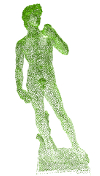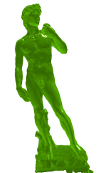High Quality Rendering of Large Point-based Surfaces.
Naveen Kumar Reddy Bolla (homepage)
Points-based models have gained popularity in recent years. The most attractive feature of the point-based primitives is its simplicity. No information about connectivity or topology of the surface is stored explicitly. Adaptive modification and dynamic sampling of the surface do not suffer from complexity and robustness like triangle mesh. The level of detail is simple, fast and almost continuous. However, points based methods suffer from surface normal discontinuities in representation. Shading is also not independent from sampling rate. Point based models can be visualized by rendering the points directly. Each sample in the representation has certain attributes (normal, color, material properties) for rendering and shading them as a continuous surface. Typically, a point sample also has a radius to define an area around it. Such samples are called surfels and approximate the shape of the surface linearly in their neighborhood. Since linear splats can only be flat shaded, such representations require a large number of samples for a good shading quality. This slows the rendering due to increase in rendering computation and related memory bus activity.
Point-based rendering suffer from the limited resolution of the fixed number of samples representing the model. At some distance, the screen space resolution is high relative to the point samples, which causes under-sampling. A better way of rendering a model is to re-sample the surface during the rendering at the desired resolution in object space, guaranteeing a sampling density sufficient for image resolution. Output sensitive sampling samples objects at a resolution that matches the expected resolution of the output image. This is crucial for hole-free point-based rendering. Many technical issues related to point-based graphics boil down to reconstruction and re-sampling. A point based representation should be as small as possible while conveying the shape well.
In the first part of this thesis, we present a compact representation for point based models using non-linear surface elements. In the second part, we present a method for fast ray casting of a dynamic surface defined by large number of attributed points called Metaballs.
Algebraic Splats: Higher-order approximations of the local neighborhood have the potential to represent the shape using fewer primitives, simultaneously achieving higher rendering speeds and quality. In this thesis, we present algebraic splats, which are low-order polynomials that approximate the local neighborhood of a pointset. We adapt the Moving Least Squares (MLS) approximation to generate algebraic splat representations for a given point set. Quadratic and cubic splats as basic rendering primitive are able to approximate point-based models using 10% or fewer points than linear splats, for equivalent visual quality. Though rendering a non-linear patch is slower compared to a linear splat, the overall speed of rendering of an object could be faster. The approximation error can also be less using a small number of higher order primitives. We represent a given point set with a user-specified small number of algebraic splats with optimal rendering quality. This is done by decimating the point set and jointly approximating each using a local algebraic surface based on the Moving Least Squares (MLS) approximation.


Our rendering provides smooth surfaces with normals everywhere. We can render polynomials directly on today's GPUs using ray-tracing because of the semi-implicit nature of the splats in the local reference domain. The major contributions of this work are: (i) A compact and lightweight representation for point geometry using nonlinear surface elements, called algebraic splats; (ii) A multi-resolution representation which provides continuous Level of Detail; and (iii) A ray-tracing approach to render the algebraic splats on the GPU. The method includes an adaptive anti-aliasing step to obtain smooth silhouettes. The David 2mm model can be represented using about 30K (or 0.8% of original) algebraic splats with little or low reduction in visual quality. We can raycast the David model with adaptive antialiasing (3X grid) at 130-150 fps and 80-90 fps with shadowing. Our method is faster by a factor of 10 on most models and require about 90% less diskspace in comparision to linear splats.
Metaballs: Since the available computational power is steadily growing, more and more science areas rely on simulations of ever-growing problem sizes producing huge amount of data to be analyzed. Simulation and experimental measurement in life sciences, physics, chemistry, materials, and thermodynamics yield large and often also time-dependent datasets. Interactive visualization is the key service that facilitates the analysis of such datasets and thus enables the researchers in those fields to quickly assess and compare the results of a simulation or measurement, verify and improve their models, and in so doing coming ever closer to understanding how dynamic processes work.
Metaballs (also known as blobs) are popular particle-based implicit surface representations. A set of them can represent smooth deformable, free-form shapes represented as the iso-surface of a scalar field. Current methods can handle only a moderate number of metaballs at interactive rates on commodity GPUs. In this thesis, we present a method to handle a million or more dynamic metaballs at interactive rates. We use a perspective grid as the acceleration structure, which is built in each frame on the GPU using fast primitives. Perspective grids provide perfect coherence to primary rays. We ray trace each grid cell at a time using an adaptation of the marching points methods to metaballs. This method extracts high performance from the SIMD GPUs of today. We show interactive handling of upto a million balls. Our method is also able to handle secondary rays, though at much reduced speeds due to the lack of coherence but is suitable for live visualization of particle-based simulations. The average build time for 1 million primitives is about 38 milliseconds and we can render a million metaballs in about 94 milliseconds. Performance of Secondary rays is not fast due to the lack of coherence, with a rendering time of 150 ms for 1K primitives. (more...)
| Year of completion: | July 2010 |
| Advisor : | P. J. Narayanan |
Related Publications
Naveen Kumar Bolla and P. J. Narayanan - Algebraic Splats Representation for Point Based Models IEEE Sixth Indian Conference on Computer Vision, Graphics & Image Processing (ICVGIP 2008), pp. 71-78, 16-19 Dec,2008, Bhubaneswar, India. [PDF]
- Naveen Kumar Bolla, P. J. Narayanan, Algebraic Splats for High-Quality Rendering of Points (Submitted to Graphical Models, Under Review).
- Naveen Kumar Bolla, P. J. Narayanan, Real-time Ray-tracing of Million Metaballs. (Submitted to EGSR)
